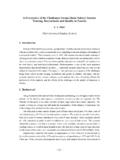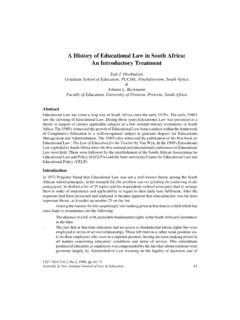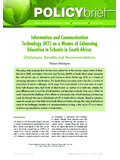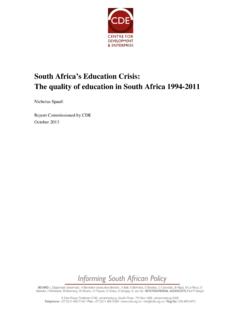Transcription of Bridging the Gap between Intended and Implemented ...
1 1 Bridging the Gap between Intended and Implemented curriculum : japanese experience of education development Yumiko Ono Naruto University of education , Tokushima, Japan Introduction A shift of the EFA focus from access more toward quality of learning after the Dakar conference (2000) accelerated curriculum reform at national level as an integral part of comprehensive educational reform in order to yield established outcomes by EFA (Chisholm and Leyendecker, 2008). In 2007, at halfway mark to 2015, EFA Global monitoring report reviewed national policies to advance EFA in thirty countries over six years period since Dakar Framework. The policy initiatives were classified under three main policy areas: developing enabling institutions, assuring access to education opportunities and creating opportunities to learn (UNESCO, 2007:221). The analysis of initiatives introduced at national level to improve learning revealed that most commonly introduced measures across the regions were curriculum -related reform(23 out of 30 countries for in-depth study), followed by reform of pre-service and/or in-service education , and free textbook distribution (UNESCO, 2007:222-231).
2 curriculum reform since EFA has stressed two things in sub-Saharan region: the need of changing curriculum content relevant to culture and learner s needs and changing teaching-learning process more leaner-centred (UNESCO, 2000:26, 28). Incorporation of HIV/AIDS (Mozambique), family life/population education in basic education curriculum (Senegal), and use of mother-tongue in early grades (Mozambique) were some examples to reform curriculum relevant to learner s needs. curriculum reform as content renewal has a long history in Africa (Obanya, 1994:4-7; Demb l and Ndoye, 2003:139-155). Aid agencies introduced learner-centered pedagogy in Africa as prescriptions through educational projects and consultancies funded by the aid agencies since 1980 s (Anderson, 2002:5; Tabulawa, 2003:9). It was EFA that urged many sub-Saharan countries to adopt new 2 curriculum for primary education that promotes learner-centered pedagogy as official pedagogy in schools (UNESCO, 2007:228-231).
3 In spite of long-time efforts to upgrade curriculum content as well as to update curriculum process, attained curriculum at learner s level remains unacceptably low in sub-Saharan Africa (Atherton, 2009; Michaelowa, 2001;UNESCO, 2004; Zahang, 2006). This suggests that curriculum policy implementation, in other words, transformation process of policy into practice, is encountering many problems and obstacles in developing countries. As Verspoor (1989:131) commented some time ago, when implementation aspect is neglected, even a good idea or innovative policy initiative would result in low outcomes. It is teachers that transform curriculum specified as policy and implement it in classrooms. The rift between two curricula remains wide unless adequate and appropriate attention is given to teachers (Demb l and Lefoka, 2007:536-539). Reimagining Teacher Problems Learning achievements as outcome are influenced by many factors but the broad consensus is that teacher quality is the single most important school variable influencing student achievement (OECD, 2005: 26).
4 To raise students achievement, it is imperative to enhance teacher quality. Teacher quality has two aspects in this context: teacher quality as human resources as input variable and teacher quality as determinant of instructional quality as process variable (Bergman, 1996:586-587). With this concept in mind, I draw on my experience of working in South Africa and Afghanistan to point out some problems concerning teacher quality. Teacher quality as Input variable Poor teacher preparation Under-qualification Low social status Low morale Absenteeism Ineffective use of school days 3 Unequal distribution of teacher resources Teacher quality as process variable Teacher belief system on learning, learners and teachers conflicting Intended curriculum No support in classrooms to transform teaching Ineffective use of teaching time It is believed that variables located closer to learners have more impact on learning outcomes, but difficult to manipulate by educational administration.
5 On the other hand, system or policy related variables are relatively easier to manipulate compared to classroom process variables. But as Verspoor (1989) and others (Rogan, 2007) point out, implementation of a system or policy is another issue. In the following section, I share some japanese education development experience which I believe have contributed to quality of teachers and teaching. japanese education development to Bridge the Gap Advancement of education in Remote Areas: More Equitable Human Resources Management In most of sub-Saharan countries, there exists a substantial learning gap by location of schools (Atherton, 2009; Zahang, 2006). Better qualified teachers have more chance to find a job in urbanized area, where people usually enjoy more favorable living conditions. In rural and remote areas, poverty may be more serious and parents may prefer their children help family instead of going to school.
6 Schools are not located in easily accessible distance. Thus children in remote isolated areas are likely to be less privileged in teacher quality and out of school conditions, both of which influence learning outcomes direct and indirect ways. This was a case in Japan until 1950 s. Student enrolment rate rose drastically since promulgation of the education Ordinance (Gakusei) in 1872 in Japan, but school attendance of children in isolated 4 and least populated areas were legally postponed or exempted in case of poverty or unavailability of schools. Many remote isolated areas were unable to establish schools from own financial resources, but existing schools were often located too far for children to commute every day. As a result, until right after the second world war, school establishment exemption areas , where establishing a school was not required due to harsh living conditions, could be found across the country, especially in rural agricultural farmland, isolated mountainous highland and on remote islands.
7 In effect, children who were born and lived in these areas were left behind and lost the opportunity to receive public education for a long time (Yamaguchi, 2004:124). A principal recalled the situation in isolated area in Iwate Prefecture right after the end of World War (1945-1950): Due to teacher absence since the beginning of the year, one branch school has remained unopened. The village is 36 kilometers from the station, and if there is no truck service, you have to walk for a whole day to get to it. There s no doctor in the village, so the usual spring check of children s health doesn t get held. Even if teachers come, there s nowhere to stay, and nobody wants to provide a room. The village and the school are in a deep valley, and from December to March, the rays of the sun don t touch the school building. The school building is old and the windows are small, so it s not possible to do any work in the school building after classes have finished.
8 We d like to have more oil for a lamp, but with the present state of oil deliveries, there s not even enough to read a newspaper, much less do any studying. Out of 10 teachers, only the principal has teaching qualifications, while the other teachers are around 20 and haven t even graduated from middle school, so principal has a really hard time. (Iwate Prefectural Board of education quoted by Yamaguchi, 2004:126). It should be noted that one finds many cases that villagers secured a place where they could privately provide basic skills to their children under these severe circumstances (Yamaguchi, 2004:124-125). It was only in 1954 that a law passed which enforces special measures to advance education in remote area by government subsidy. Later, legal regulations clarified the criteria to identify remote isolated areas 5 and a variety of policies were Implemented targeting on those schools to advance quality of education .
9 Right to quality basic education has undoubtedly benefitted from the law, but voices of teachers who had pleaded for improving poor conditions in these areas generated nationwide movement leading to enactment of the law (Saito, 2004:27-28). Personnel Deployment Policies : Relocation and Exchange Across Boundaries After the enactment of the law to advance education in remote areas, there were very few teachers who were willing to work in schools in remote areas. Low salary and insufficient food supplies in remote areas after the war did not attract teachers. As a result the quality of education in remote area was significantly lower than populated areas due to higher proportion of non-qualified teachers. This situation began to change after the enactment of law on local education administration in 1956. The law authorizes a prefecture or designated cities to employ and deploy teachers for schools of compulsory education .
10 From then, a system has started that a municipality is responsible for establishing compulsory education schools and supervising educational staff, while a prefecture assumes the responsibility of payment of salary and employment and deployment of teachers. Across prefectures, the following common principles can be pointed out in teacher relocation: 1. Exchange and relocation of teachers across city and county areas 2. Exchange and relocation of teachers across remote and populous areas 3. Appropriate mix of teacher composition 4. Relocation of staff who have stayed in one school for a long period (Takahashi, 1992:21) Besides, some researchers emphasize the importance of teacher relocation from TPD perspective. It is argued that teachers may suffer from mannerism if they work in a same school for a longer period and experience of working in different schools in diverse areas is essential for TPD (Satake, 1992: 32).



